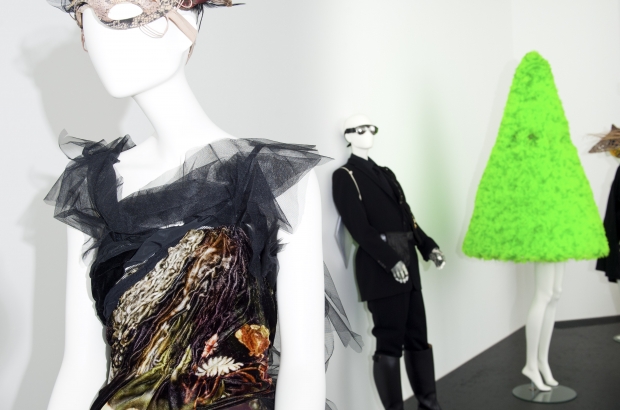- Daily & Weekly newsletters
- Buy & download The Bulletin
- Comment on our articles
The DNA of Belgian fashion
Fashion in and from Belgium is doing exceptionally well. Raf Simons now heads Dior, and John Galliano just took over the reins at Maison Margiela, ushering in an exciting new era for the fashion house founded by Limburg native Martin Margiela.
Graduates from local schools routinely make their way to prominent positions at international brands or start their own labels. And yes, the Antwerp Six are still alive and kicking – but they’re no longer our sole export product.
High time, in other words, for a retrospective that tells the story of Belgian fashion from beginning to end.
With The Belgians: An Unexpected Fashion Story, Bozar offers an overview of the country’s fashion throughout the decades. It’s the first retrospective of its kind and long overdue. After all, many of the designers on view were recently feted in exhibitions of their own, while other names from our fashionable past urgently needed rescued from oblivion.
The show was curated by Didier Vervaeren, ex-artistic director at Delvaux, teacher at Brussels fashion academy La Cambre and inventor of a signature look that makes him as recognisable as Karl Lagerfeld to anyone who is anyone in the Belgian fashion scene.
Vervaeren saw Bozar as the ideal location and now as the right moment: The opening of The Belgians coincides with the inauguration of the new MAD Centre for Mode and Design at the nearby Oude Graanmarkt.
Instead of opting for a chronological approach, Vervaeren chose to celebrate Belgian fashion thematically. Ten rooms shed light on the subject from 10 different angles, with the works of nearly 100 designers on view.
Coco Chanel of the north
The first room visitors enter is an amalgam of what it means to be Belgian: free-spirited, idiosyncratic and with a penchant for the surreal. A typical lace fan is on display next to a statue of Manneken Pis in a Delvaux lab coat.
We see Margiela’s famous Tabi boots, modelled after the traditional Japanese toe socks; Christophe Coppens’ crazy deer cape and a hat by Elvis Pompilio that looks like a pot of mussels turned upside down. Welcome to Belgium.
Visitors are then introduced to Belgium’s first couture house. A joint venture between dressmaker Honorine Deschrijver and 20th-century patron Paul-Gustave van Hecke, Norine excelled in original designs inspired by the avant-garde artists of the interbellum.
Painter René Magritte famously designed invitations for the couple’s fashion shows, and Deschrijver was called the Coco Chanel of the north. Just a few examples of her work survive today; one is included in the exhibition.
An army of mannequins represents the heirs of Norine from the 1960 to the present day. Some of the designers here are barely known to modern audiences – knitwear pioneer Ann Saelens, for example, and Yvette Lauwaert, who once ran a much-beloved fashion store in Ghent.
Others, like the Antwerp Six, are world famous. Dries Van Noten, Walter Van Beirendonck, Dirk Van Saene, Dirk Bikkembergs, Marina Yee and Ann Demeulemeester graduated from Antwerp’s Royal Academy of Fine Arts in the early 1980s and took the fashion world by storm when they presented their collections together in London.
To many, the Six are still synonymous with Belgian fashion, but the exhibition also highlights the talented designers that came after them. There’s Olivier Theyskens, who rose to prominence working for houses like Rochas and Nina Ricci; Peter Pilotto (a Flemish, Austrian duo); and Haider Ackermann, a Colombian designer who is often labelled “Belgian” because he studied in Antwerp.
Belgian by training
In fact, a lot of the designers included in The Belgians aren’t Belgian at all. In a country famous for its multitude of languages and governments, a local education, it seems, is enough to merit honorary citizenship.
Indeed, studying fashion in Belgium appears to be a defining experience. There are seven fashion schools here, and some, like the Academy in Antwerp and La Cambre in Brussels, are among the best in the world.
Unsurprisingly, an entire room called “Laboratories” is devoted to the local schools and their alumni. In that same space, one designer receives a special mention. Martin Margiela is without a doubt the most enigmatic name in Belgian fashion.
He chose to remain quite anonymous throughout his career and secretly retired from his eponymous fashion house in 2009. Enfant terrible Galliano currently leads the design team and humbly adopted the white lab coat worn by all Margiela employees over his signature baroque-pirate style.
The exhibition continues with a space devoted to the cross-pollination between fashion and art – Walter Van Beirendonck, Dries Van Noten and Tim Van Steenbergen all designed opera costumes – while another focuses on the ecological aspect of local fashion.
A couple of years back, Flemish designer Bruno Pieters launched Honest By, the first fashion label that is 100% transparent. The tags on each garment show the origin and cost of every single thread and button used.
The Belgians finishes with 12 silhouettes by upcoming designers – recent graduates of local schools or from young labels with bright futures ahead of them. Perhaps just as instructive is the “Limitless” room, where the emphasis is on the international allure of Belgian fashion, and a recording helps foreign visitors practice the correct pronunciation of some of those more difficult Flemish names.
Pay attention if you want to be able to say “Ann Demeulemeester” or “Raf Simons” without making a fool of yourself when you tell your friends everything they need to know about Belgian fashion.
Until 13 September at Bozar, Ravensteinstraat 23, Brussels














